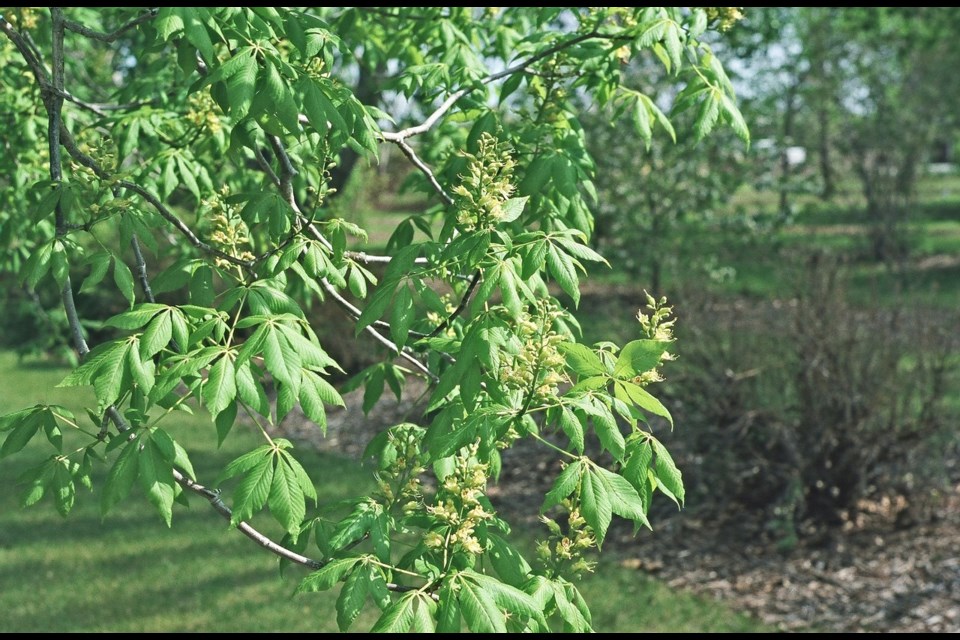What better way to celebrate Arbor Week, May 20 to 28, than to participate in one of the many events being organized by the SOS Trees Coalition? This year’s theme is Healthy Trees, Healthy People: from speakers to art in the park, green exercise, tree tours and so much more. For the complete schedule: https://www.sostrees.ca.
And, it’s been said that the best time to plant a tree was 20 years ago, the second-best time is today. So, plant a tree during Arbor Week! Considerations include hardiness (generally zones 2-3 on the prairies); four-season beauty; insect and disease resistance and its ultimate size.
Many trees have spring flowers, but also think foliage: spring, summer or fall colour? Attractive texture? Finely cut or compound leaves? Evergreens for winter value? Don’t overlook the colour and texture of stems and bark. Fruit may be an added attraction, especially if it is held through the winter and attracts birds.
Know your tree’s mature height and spread, including the depth and spread of its root system. Will roots eventually cause a driveway or sidewalk to heave? Be a danger to your house foundation? If shallow-rooted and wide spreading, will they rob your flower or vegetable beds of moisture and nutrients?
From the tree’s perspective, does it have a soil preference? Prefer sun or shade? What are its water needs?
As many homes in newer areas of our cities have less space, below are trees recommended for smaller lots.
‘Dropmore’ little leaf linden (Tilia x flavescens ’Dropmore’) is a hybrid of the American basswood and little leaf linden. Introduced by Frank Skinner in 1955, it is long-lived, insect and disease resistant, fast-growing and adapted to drier soils. Pyramidal and upright with a dense, compact crown, its mature height is about 40 feet.
Prairie Dream paper birch (Betula papyrifera ‘Varen’) can be single or multiple trunked, has snow-white peeling bark and golden fall colour. Oval in form and 40 feet high, it’s fast-growing, does best in evenly moist soil and is resistant to bronze birch borer.
Prairie Horizon alder (Alnus hirsuta ‘Harbin’) was selected for its drought tolerance and fast growth to 40 feet. With purple catkins in the spring, yellow foliage in the fall, and clusters of brown cone-like fruit throughout the winter, this is a tree with year-long interest. It is adaptable to both sun and shade, from dry soil to standing water.
Ohio buckeye (Aesculus glabra) has distinctive palmately compound leaves and large, attractive creamy white flowers in late June. About 40 feet high, it does best in full sun in fertile, well-drained soil.
Swiss stone pine (Pinus cembra) is slow growing and, at 30 feet, one of the best pines for a smaller landscape. It’s dense, narrow and columnar with smooth grey-green bark and long soft needles in bundles of five.
‘Thunderchild’ flowering crabapple (Malus baccata), introduced by Percy Wright of Saskatoon in 1978, is a small, dense tree of about 12 feet with a round spreading form. It has dark, purple-red foliage and single pink flowers in spring, small red fruit and exceptional resistance to fireblight.
‘Spring Snow’ flowering crabapple (Malus baccata), a seedling selected b Bert Porter of Parkside, Sask, is about 25 feet high with a round form and bright green foliage. The glistening single white flowers are fragrant and mostly sterile so there is little or no fruit – a plus for gardeners who hate mess.
Showy mountain ash (Sorbus decora) is the hardiest and most disease-resistant of our mountain ashes. An attractive small tree of about 25 feet, it has pinnately compound leaves that turn orange in the fall and white flowers followed by orange-red berries attractive to birds through the winter.
Klondike Amur cherry (Prunus maackii ‘Jefdike’), a small tree of 25 feet, was selected for its outstanding orange-red bark with improved resistance to frost cracking. White spring flowers are followed by tiny black fruit in mid-summer
‘Ming’ Amur cherry (Prunus maackii ) has attractive burgundy-coloured exfoliating bark with prominent horizontal lenticels that is resistant to frost cracking. About 25 feet high with yellow fall foliage, it’s best in full sun in moist but well-drained soil. The small fruit is attractive to birds.
‘Princess Kay’ flowering plum (Prunus nigra) is a selection of the Canada plum from northern Minnesota. Only 15 feet high with an upright, spreading form, it’s covered in showy double-white flowers in early spring. The plums are small and sparse. It’s exceptionally hardy and drought-tolerant and does best in full sun on well-drained soil.
‘Delta’ hackberry (Celtis occidentalis) looks similar to the American elm but without the problem of Dutch elm disease. About 45 feet in height with a rounded form, it has beautiful corky bark and is adaptable to even difficult sites. Drought-tolerant once established it should be grown in full sunlight.
Sara Williams is the author and co-author of many books including Creating the Prairie Xeriscape, Gardening Naturally with Hugh Skinner and, with Bob Bors, the recently published Growing Fruit in Northern Gardens. She continues to give workshops on a wide range of gardening topics throughout the prairies.
This column is provided courtesy of the Saskatchewan Perennial Society (SPS; [email protected] ). Upcoming event - Spring Plant and Seed Exchange and Plant Sale Tuesday, May 30th 6:30 p.m. at Saskatoon Forestry and Zoo Hall. Check our website (www.saskperennial.ca) for more details.




